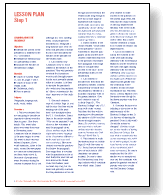

Click on the icon for Lesson 1 in Adobe Acrobat Format (98K). Includes Activity Pages 1A and 1B.
LEARNING ABOUT THE PRESIDENCY
Objectives
- Identify the powers of the presidency as defined by the U.S. Constitution.
- Interpret an electoral map of a presidential contest.
- Examine the function of the Electoral College.
Materials
- Copies of Activity Pages 1A and 1B.
- Copies of maps of the United States.
- Chalkboard, chalk.
- Pens or pencils.
Subjects
Geography, language arts, math, social studies
Procedure
1. Tell your students that you are going to describe an important national
event for them to guess. Give these details: This event takes place once
every four years in November; many Americans take an interest in it; the
press begins to cover this event at least one year before it happens; if
you watch television, listen to the radio, or read the newspapers you see
many advertisements and hear stories about it; thousands of people meet
every four years during the summer to prepare for it; and although it is
not a sporting event, some people have described it as being like a long
distance race. Your students will probably conclude that you have described
the election of the president
of the United States.
2. Ask students why Americans show so much interest in the election
of the president. They will probably conclude that Americans want to pick
the right person for the most powerful elected office in America. Ask them
to describe the president's job – what does the president do? Have a volunteer
list the class' responses on the chalkboard.
3. Give each student a copy of Activity Page 1A and tell the class
that they will be reading part of the president's job description from the
U.S. Constitution. Direct them to the section entitled "Who can be
president?" and choose a few volunteers to read the paragraph aloud.
(Some students might find the eighteenth-century language of the Constitution
difficult to understand and may need extra coaching.) Have your students
answer the questions that follow the paragraph. Encourage them to consider
why the president must be at least thirty-five years old and have lived
in the United States for fourteen years. Answers may vary, but students
will probably conclude that the president must be old enough and have lived
in the United States long enough to have had a wide range of experience
with national issues. (Life expectancy was significantly shorter during
the eighteenth and nineteenth centuries than it is today, making thirty-five
a relatively mature age then.)
4. Direct students to the section entitled "Some duties of the
president." Choose volunteers to read the paragraphs aloud and then
have students write their responses to the questions that follow each paragraph.
Encourage them to compare their answers to the class' list of presidential
duties (on the chalkboard).
5. Ask students to describe how they think the president is elected.
Students will probably conclude that the president is elected by a majority
of popular votes in the general election. Give each student a copy of Activity
Page 1B, "The Electoral College" and a U.S. map (with states'
names). Tell them that they will be learning about the presidential election
of 1888 and that the result might surprise them. (To establish a context,
you may wish to tell your students that this election occurred between the
Civil War and World War I.)
6. Tell students to mark the electoral map on Activity Page 1B with
the names or U.S.
Postal Service abbreviations of each state in 1888 (territories are
already marked). Be sure to stress that the electoral map shadings indicate
which candidate won which states. Direct your students to write answers
to the questions on the activity page. Next, tell them that the small numbers
on the map represent the electoral votes of the states. (Use the Introduction
as a guide to discuss the concept of the Electoral College). Be sure to
stress that a state's number of electors is equal to its number of senators
and representatives.
7. Ask your students to add up the numbers in the states with dark
shading (electoral votes for Benjamin Harrison) and the numbers in the states
with light shading (electoral votes for Grover Cleveland). (You may have
students add the numbers on the chalkboard.) Which candidate had the greater
number of electoral votes? Students should conclude that Harrison did. Tell
them that as a result, Harrison won the election even though he had fewer
popular votes than Cleveland.
8. Conclude the lesson by initiating a discussion on the relative
merits of the Electoral College system. Is it a fair way of electing the
president? Does it still work? Should the system be changed? (Students might
not see the benefits of having the Electoral College. You may wish to mention
that the system encourages the stability of well-organized, locally based
parties at the expense of less-established, third-party movements.) Be sure
to emphasize that the 1888 election was an exceptional case and that candidates
who garner the greatest number of popular votes also usually win the Electoral
College vote.